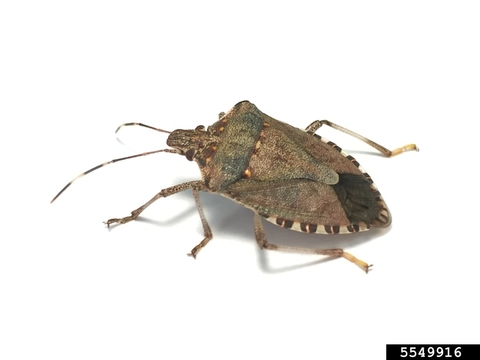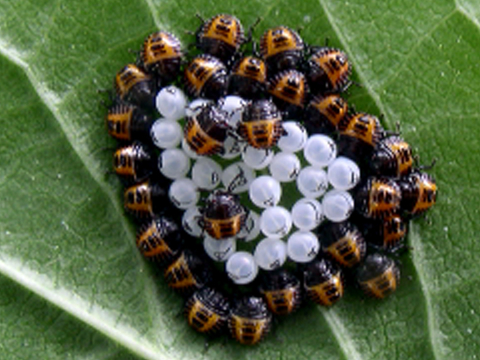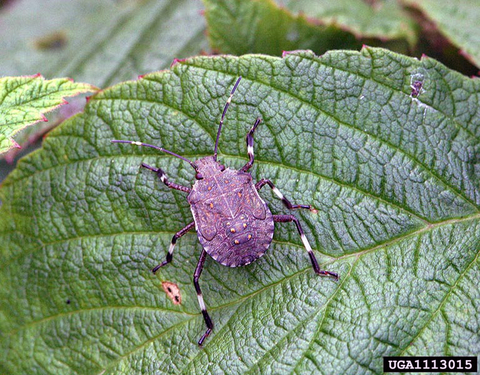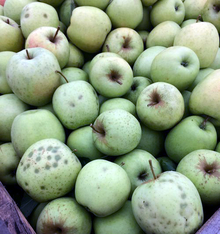Quick facts
- Brown marmorated stink bug (BMSB) is an invasive species.
- They feed on approximately 200 different plant species, including many fruits, vegetables and row crops.
- They spend the winter in buildings, including homes in urban areas.
- You can tell BMSB apart from native stink bugs by looking for alternating light and dark bands on the antennae and abdomen.
The Minnesota Department of Agriculture monitors this invasive species. Please report any BMSB you spot at Report a Pest.
The brown marmorated stink bug (Halyomorpha halys) is not native to the United States. It arrived undetected from Asia in the United States in the 1990s and was first detected in Minnesota in 2010. Its current North American range includes the Eastern and Midwestern United States and Canada.
The Minnesota Department of Agriculture tracks this insect in Minnesota, and it has been detected in many parts of the state.
How to identify brown marmorated stink bugs (BMSB)
Adults
- Adults are shield-shaped, mottled brown in color, and have a smooth rounded shoulder.
- A key identifying feature is alternating dark and light bands on their antennae and abdomen.
- BMSB gives off an unpleasant odor when disturbed or crushed.
- A free Midwest Stink Bug Assistant app has been developed by the University of Minnesota Extension IPM Program, the Minnesota Invasive Terrestrial Plants and Pests Center, and Purdue University. The app provides photographs of other insect species that look similar to BMSB and shows how to distinguish "look-alikes" from BMSB. The app is available for both Apple and Android.
Nymphs and eggs
- Barrel-shaped eggs are laid in clusters on leaves.
- Newly hatched nymphs have a yellow-red abdomen.
- Older nymphs are darker in color.
Biology
- Adult BMSB typically emerge in May, mate, and begin laying eggs by late May and June.
- The immature nymphs hatch and feed on plants until they reach adulthood.
- In Minnesota, these “summer adults” will produce a partial second generation of nymphs.
- By late August-September, a mixture of late-instar nymphs and adults will be present.
- Populations are highest from mid-August through October.
- In the fall, adults seek shelter in structures, particularly in older buildings where windows may not be sealed.
Damage
- We do not commonly see significant damage on plants from BMSB in Minnesota, though the invasive insect is a major pest in other states.
- BMSB nymphs and adults feed on more than 200 species of plants.
- BMSB feed with a straw-like mouthpart, which it uses to puncture and suck juices from plant tissue.
- When they feed on developing fruit, they can cause seed abortion, discoloration and deformation.
- BMSB has caused significant damage in other states to apples, beans, eggplants, grapes, peppers, sweet corn, swiss chard and tomatoes.
Managing brown marmorated stinkbugs in homes
Brown Marmorated stink bugs need somewhere warm to spend the winter, and they most often do this in people’s homes. This leads them to cluster on the sides of homes in the fall and work their way into homes to spend the winter. Unlike other stink bugs found in Minnesota, BMSB prefers to overwinter in homes.
- Cooler temperatures trigger stink bugs to look for places to spend the winter.
- Stink bugs can gather in high numbers on the sunny sides of buildings on warm winter days.
- Bugs can be removed with a shop vac and emptied into a bucket of soapy water.
- Stink bug biology makes it hard to treat stink bugs with insecticides, making physical removal more effective.
- Brown marmorated stink bugs spend the winter hunkered down.
- In the winter months, they do not lay eggs, reproduce, damage homes, or bite
- They often are in places in our homes we can’t see, but on warm days or when we turn up the thermostat, they sometimes can be seen.
- You can remove bugs by hand or by vacuuming them up and depositing them outside.
- Pesticides are not recommended for indoor use to treat brown marmorated stink bugs.
- If you want to see fewer bugs in your home next winter, check your homes for poor seals around doors, windows (including screens), and areas where cords, pipes, and cables enter your home. Seal these points to limit places where bugs can enter your home.
Managing brown marmorated stink bugs in gardens
While stink bug populations are big enough to be a nuisance in homes, we haven’t received reports of damage in Minnesota gardens. Brown marmorated stink bug-specific management is not needed. Physically removing the insects and placing them in a soapy bucket of water can be an option if found on plants.
Managing brown marmorated stink bugs on farms
There haven’t been reports of major crop losses due to brown marmorated stink bugs in Minnesota.
In wine grapes, BMSB feeding can cause the berry to soften and possibly become a pathway for pathogens. But what may be a greater concern is the potential threat of BMSB as a contaminant. In the eastern U.S., adults and nymphs have been observed tucked into grape clusters as temperatures become cooler near harvest. This creates the possibility of harvesting BMSB along with grape clusters. In the wine-making process, the chemicals released by BMSB could taint the wine, thus rendering it unmarketable.
For more information on BMSB management in apples (available in multiple languages), see the FruitEdge BMSB pest profile.
Reviewed in 2022





